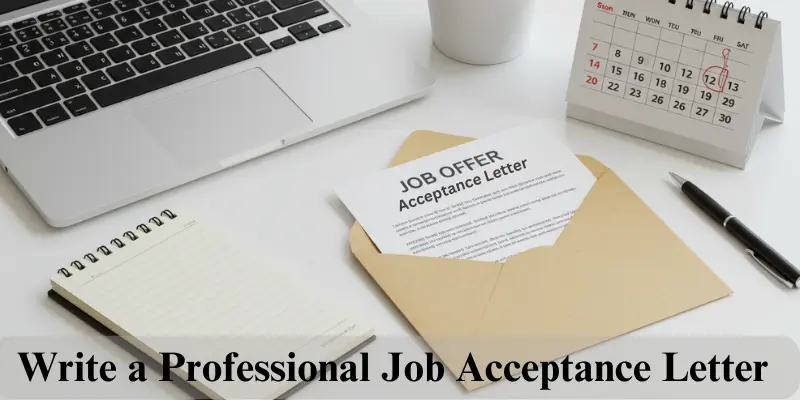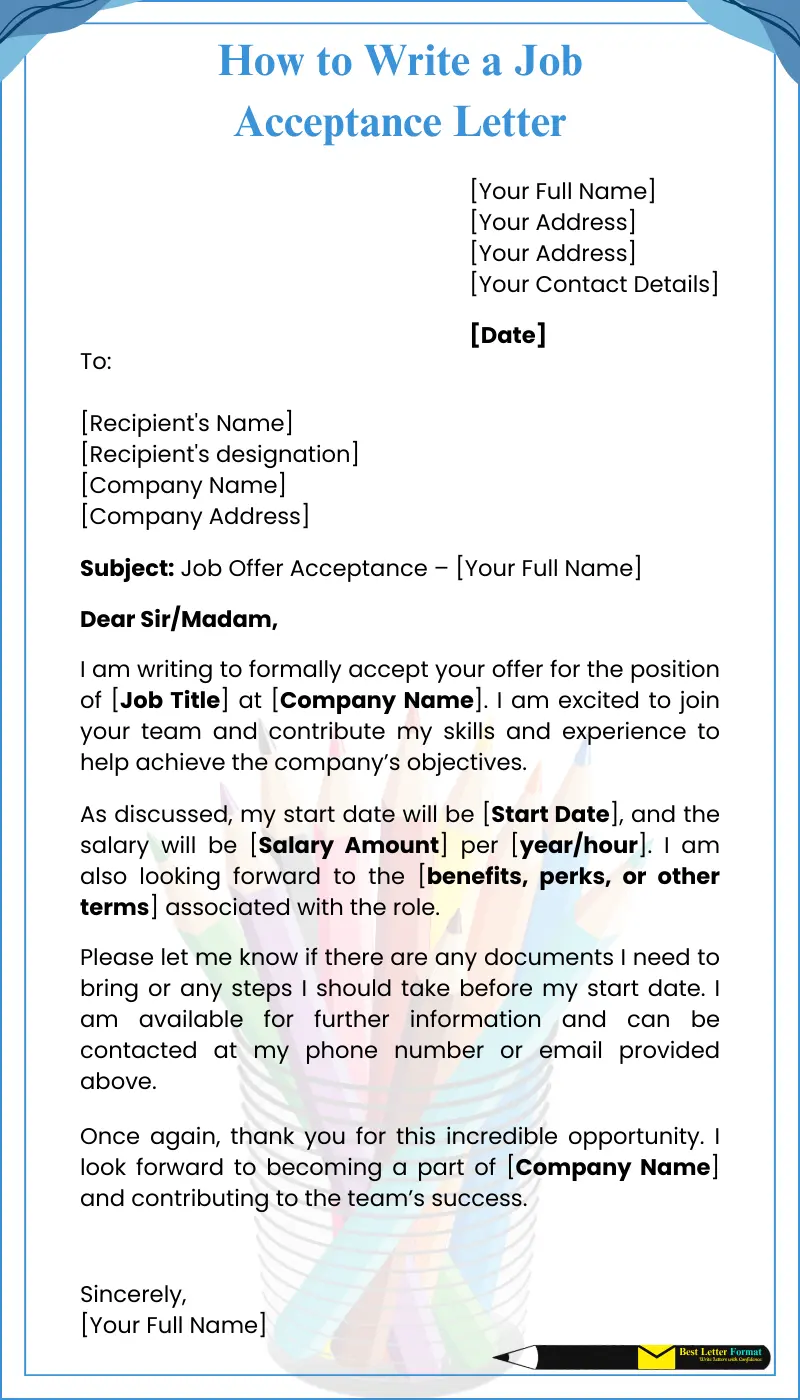The Complete Guide: How to Write a Job Acceptance Letter with Confidence
Published: 11 Mar 2025
Accepting a job offer is one of the most exciting moments in your career. But have you ever wondered what the best way is to formally accept a job and ensure everything is set for your new role? A job acceptance letter is the perfect way to do just that.

Not only does this letter serve as your formal confirmation to the employer, but it also sets the tone for the relationship you’ll have with your new company. It’s your chance to express enthusiasm, thank the employer, and make sure you’re both on the same page regarding important details like salary, start date, and job responsibilities.
In this guide, we’ll walk you through how to write a job acceptance letter step-by-step. From key components to best practices, we’ll explore everything you need to know to make your letter both professional and personal. Ready to learn how to craft the perfect acceptance letter? Let’s dive in!
1. Understanding the Job Acceptance Letter
So, you’ve finally landed the job—congratulations! The hard work, the interviews, the nerves—it all paid off. Now comes the moment to officially say, “Yes, I’m ready!” But how do you put it into words? That’s where the job acceptance letter comes in.
A job acceptance letter is not just a formality—it’s your opportunity to express your excitement, gratitude, and commitment to your new role. It’s a way to show your new employer that you’re eager to start this new chapter with them.
Here’s why it matters so much:
- Shows your excitement: A well-written letter lets you express your genuine enthusiasm for the job and company.
- Clarifies expectations: It helps ensure you and the employer are clear on the important details like your start date, salary, and responsibilities. No confusion, just excitement!
- Confirms your commitment: This is your chance to say, “I’m all in!” It shows that you’re fully dedicated to starting this journey.
- Makes a great first impression: Your first official act as part of the team—writing a professional, thoughtful letter—leaves a lasting positive impression on your employer.
Think of the job acceptance letter as the first step in a new adventure—a small but important piece of the puzzle that will kick off your career with a bang! It’s your way of saying, “I’m ready for this!”
2. Key Components of a Job Acceptance Letter
Now that we understand the importance of a Job Acceptance Letter, let’s quickly go over the key elements that will make yours professional and impactful.
Key Components of a Job Acceptance Letter:
- Addressing the Letter Correctly
Make sure to address the right person (usually the hiring manager) using their full name and title. - Expressing Gratitude
Acknowledge the opportunity with a simple “Thank you for this incredible opportunity to join [Company Name].” - Confirming the Job Offer
Clearly state that you are accepting the offer, for example: “I am excited to accept the position of [Job Title].” - Reiterating Employment Terms
Mention your start date and salary to confirm all details are aligned. - Clarifying Any Details
If you’re unsure about anything (like work hours or benefits), now’s the time to ask for clarification. - Signing Off Professionally
End with a professional sign-off like “Best regards” or “Looking forward to joining the team.”
Now that we’ve covered these key components, let’s dive into the step-by-step guide on how to write a job acceptance letter that will leave a lasting impression!
3. Step-by-Step Guide to Writing a Job Acceptance Letter
You’ve got the key components down, now it’s time to put it all together. Writing a job acceptance letter is easier than it sounds, but it’s essential to get it just right. Follow these steps, and you’ll have a polished, professional letter ready to send quickly. And don’t worry—this process is simple, and a little bit of enthusiasm can make all the difference!
1. Choosing the Right Format
The first thing to consider is whether you’ll send a formal letter or an email. Both are perfectly acceptable, but emails are quicker and more convenient. A letter, however, adds a more personal touch.
Example:
- Formal Letter: If you’re mailing it, be sure to use the company’s letterhead and print it out.
- Email: Keep it professional, but you can skip the letterhead. Just focus on clear, friendly language.
2. Contact Information (Your Information)
Start your letter by including your contact information at the top. This is essential for a formal letter but can also be included at the bottom in an email signature.
What to include:
- Your full name
- Your address
- Your phone number
- Your email address
3. Date
The date the letter is written should go directly after your contact information. This will help the recipient know when the letter was sent and also provides a reference for any follow-ups.
(DD, MM, YYYY)
4. Recipient Information (Employer’s Details)
To personalize your letter, include the recipient’s contact information to personalize your letter. Be sure to include the hiring manager’s name and the company’s address.
What to include:
- Hiring manager’s full name
- Their job title
- Company name
- Company address
5. Subject Line (For Email & Letter)
For an email, the subject line is critical. It should be clear, direct, and let the employer know the purpose of your email. For a formal letter, this step is skipped, but it’s still important to make your intention clear in the opening paragraph.
For email:
- Subject: “Job Acceptance – [Your Name]”
6. Greeting
This part is about addressing the recipient in a respectful and professional way. Always use a formal greeting and address them by their proper title.
Examples:
- “Dear Mr. [Last Name],”
- “Dear Ms. [Last Name],”
Tip: If you’re unsure of gender, use their full name or simply “Dear Hiring Manager.”
7. Opening: Express Gratitude and Confirm Acceptance
The opening of your job acceptance letter should immediately express gratitude for the opportunity and confirm your acceptance of the offer. This is your first chance to make a positive impression, so be sure to convey your excitement!
Key Points:
- Thank them for the offer
- Confirm your acceptance
Example:
“I am writing to formally accept your offer for the position of [Job Title] at [Company Name]. I am truly excited to join the team and look forward to contributing to the company’s success.”
8. Reiterate the Terms of Employment
Now that you’ve confirmed the offer, it’s time to reaffirm the terms of your employment. This includes your start date, salary, and any other key details discussed during the interview process.
What to include:
- Start date
- Salary and compensation
- Job title
- Any additional benefits
Example:
“As discussed, my start date will be March 15, 2025, with an agreed salary of $60,000 per year, and I am excited to begin working with your talented team.”
9. Clarify Any Final Details
Before wrapping up your letter, this is your chance to clarify any remaining details about the job or your start date. Whether it’s about the work schedule, the office location, or documents you need to provide, this helps set the right expectations and ensures a smooth transition into your new role.
Additionally, you can let the employer know that you’re available for any further communication or to answer any questions.
What to include:
- Any outstanding details like the first-day schedule, office location, etc?
- Any documents you may need to bring on your first day
- Questions about the role that weren’t covered yet
Example:
“Please let me know if there are any documents I need to bring on my first day or any additional steps I should take before my start date.”
Feel free to contact me if you need any further information. I have mentioned my mobile number and email ID at the top for your ready reference.
10. Conclusion: Reaffirm Excitement and Gratitude
The conclusion is your final opportunity to show enthusiasm and reaffirm your appreciation. A little warmth and positivity can go a long way in making your letter memorable.
What to include:
- Reaffirm your enthusiasm for the role
- Thank them again
Example:
“I am looking forward to joining [Company Name] and contributing to the continued success of the team. Thank you again for this incredible opportunity.”
11. Signature
In your formal letter, end with a professional closing, followed by your signature. For an email, a typed signature works, but still make sure it’s professional.
What to include in your signature:
- Your full name
- Your title (optional)
4. How to Write a Job Acceptance Letter: A Customizable Template
Use this job acceptance letter template to easily confirm your new position. Simply customize the details like start date, salary, and benefits to make it your own!
[Your Full Name]
[Your Address]
[Your Address]
[Your Contact Details]
[Date]
To:
[Recipient’s Name]
[Recipient’s designation]
[Company Name]
[Company Address]
Subject: Job Offer Acceptance – [Your Full Name]
Dear Sir/Madam,
I am writing to formally accept your offer for the position of [Job Title] at [Company Name]. I am excited to join your team and contribute my skills and experience to help achieve the company’s objectives.
As discussed, my start date will be [Start Date], and the salary will be [Salary Amount] per [year/hour]. I am also looking forward to the [benefits, perks, or other terms] associated with the role.
Please let me know if there are any documents I need to bring or any steps I should take before my start date. I am available for further information and can be contacted at my phone number or email provided above.
Once again, thank you for this incredible opportunity. I look forward to becoming a part of [Company Name] and contributing to the team’s success.
Sincerely,
[Your Full Name]

5. Best Practices for Writing a Job Acceptance Letter
Now that you know what to include in your job acceptance letter, let’s talk about how to make it truly stand out. Following some best practices ensures your letter comes across as professional, polished, and leaves a great impression on your new employer.
Here are some simple but effective tips to keep in mind while writing your job acceptance letter:
1. Be Prompt
Timing matters! Once you’ve made the decision to accept the offer, don’t wait too long to send your acceptance letter. Ideally, you should respond within 1-2 days. It shows that you’re enthusiastic and serious about the role.
2. Keep It Professional
Even if you feel super excited (and you should!), make sure the tone of your letter stays professional. Use polite language, maintain a respectful tone, and avoid overly casual phrases or emojis. Think of this letter as a formal document, even if you’re sending it by email.
3. Be Clear and Concise
No need to write a lengthy essay. Stick to the point—express your gratitude, confirm the key details (like your start date and salary), and show enthusiasm for the role. A well-structured letter that’s easy to read makes a stronger impact.
4. Double-Check the Details
This part is super important! Before sending your letter, carefully review the job offer to make sure everything mentioned (like your job title, salary, start date, and benefits) matches what was discussed. Accuracy helps avoid any confusion down the road.
5. Proofread Before Sending
Spelling mistakes or grammatical errors can leave a bad impression. Take a few extra minutes to proofread your letter. Reading it out loud can also help you catch any awkward phrasing or typos.
6. Use a Positive and Enthusiastic Tone
Let your excitement show! A positive tone makes your letter feel genuine and leaves the employer feeling good about their decision to hire you. You’re joining their team—so it’s okay to sound happy about it!
7. Close with Gratitude and Professionalism
End your letter on a warm note. Thank them again for the opportunity and reaffirm that you’re looking forward to joining the company. Sign off politely with a closing like “Sincerely” or “Best regards,” followed by your full name.
Pro Tip: Save a copy of your acceptance letter for your own records! It’s always good to have everything in writing in case you need to refer back to it later.
6. Different Scenarios for Writing a Job Acceptance Letter
Once you know the best practices, it’s important to recognize that job acceptance letters aren’t always one-size-fits-all. Depending on the situation, your approach might vary slightly. Below are 10 common scenarios, with guidance on how to handle each professionally.
1. Standard Job Offer Acceptance
You’ve received a straightforward offer and are happy to accept.
- Thank the employer for the opportunity.
- Confirm your acceptance.
- Reiterate important details (start date, salary).
Example:
“I am pleased to accept the position of [Job Title] at [Company Name], starting on [Start Date].”
2. Acceptance After Negotiating Terms
You negotiated certain terms, and both parties have reached an agreement.
- Express gratitude for the updated offer.
- Confirm the revised terms (salary, benefits, start date).
- Keep the tone positive and professional.
Example:
“I am happy to accept the updated offer for [Job Title], with a start date of [Date] and a salary of [Revised Salary].”
3. Written Confirmation After Verbal Acceptance
You’ve accepted the offer verbally and are now following up in writing.
- Refer to the earlier conversation.
- Confirm your acceptance formally.
- Restate the agreed-upon terms.
Example:
“As discussed in our conversation on [Date], I am pleased to formally confirm my acceptance of the [Job Title] role.”
4. Acceptance with Pending Clarifications
You’re accepting the offer but need additional information clarified.
- Confirm your acceptance clearly.
- Request clarification on specific details (benefits, work hours).
- Offer to provide any documents needed.
Example:
“I am excited to accept the offer and look forward to starting on [Date]. Kindly clarify [specific topic] before my start date.”
5. Internship or Part-Time Job Acceptance
For internships or part-time roles, your letter can be simpler but still professional.
- Thank the employer.
- Confirm key details like hours and compensation.
- Express enthusiasm for the opportunity.
Example:
“I am pleased to accept the part-time position at [Company Name], working [Number of Hours] per week starting from [Date].”
6. Remote Position Acceptance
You’re accepting an offer for a remote role.
- Confirm your acceptance of the position.
- Clarify work expectations related to remote duties.
- Confirm start date, time zone alignment, or equipment setup if necessary.
Example:
“I am excited to accept the remote position of [Job Title] at [Company Name], starting on [Date]. Please let me know about any remote onboarding procedures.”
7. Freelance or Contract Role Acceptance
You’ve been offered a freelance or contract-based role.
- Confirm your acceptance.
- Clarify the project scope, deliverables, and payment terms.
- Mention your availability for the project kickoff.
Example:
“I am pleased to accept the contract offer for [Project Name]. I look forward to starting on [Start Date] and delivering the agreed milestones.”
8. Delayed Start Date Acceptance
You’ve agreed on a later start date due to prior commitments.
- Thank the employer for their flexibility.
- Confirm the delayed start date.
- Reaffirm your enthusiasm for the role.
Example:
“Thank you for accommodating my schedule. I am happy to accept the role of [Job Title] at [Company Name], starting on [Delayed Start Date].”
9. Acceptance with Relocation Considerations
You’re accepting the offer but need to coordinate relocation.
- Confirm your acceptance of the offer.
- Clarify relocation support (if discussed) or timelines.
- Confirm your readiness to begin as planned.
Example:
“I am pleased to accept the position of [Job Title]. As discussed, I will be relocating and am on track to start on [Date].”
10. Reaccepting After a Reinstated Offer
You were previously offered the job, but for some reason, the process was delayed and the offer has been reinstated.
- Express appreciation for the renewed opportunity.
- Confirm your acceptance again.
- Restate the job terms for clarity.
Example:
“Thank you for reinstating the offer for [Job Title]. I am happy to accept and look forward to starting on [Date] as agreed.”
Pro Tips:
Whichever scenario fits your situation, remember to keep your tone professional and positive. Your acceptance letter sets the tone for your future working relationship.
7.FAQs About Job Acceptance Letters
When it comes to writing a job acceptance letter, a few common questions often come up. To make things easier, here are answers to some of the most frequently asked questions to guide you through the process.
A job acceptance letter is a formal communication you send to an employer to confirm that you are accepting their job offer. It’s a professional way to show enthusiasm, clarify details, and express gratitude.
Yes. Even if you’ve given a verbal confirmation, sending a written acceptance letter (or email) is important because:
- It makes your acceptance official and formal
- It documents key details (start date, salary, etc.)
- It creates a professional record of your communication
Ideally, you should send your acceptance letter within 24 to 48 hours of receiving the official job offer. Prompt communication shows professionalism and enthusiasm.
A complete job acceptance letter should cover these essentials:
- A clear statement accepting the offer
- Gratitude for the opportunity
- Confirmation of the job title, start date, and salary
- Any clarifications or next steps
- A professional closing and signature
Absolutely. Email is commonly used for job acceptance letters today, especially for speed and convenience. Just make sure to maintain a formal tone and double-check for any typos or errors before hitting send.
Keep the tone:
- Professional
- Positive and enthusiastic
- Clear and concise
You’re starting a new professional relationship, so first impressions matter.
Yes, it’s a good practice to restate the key terms that were discussed and agreed upon. This helps avoid misunderstandings. Typically, mention:
- Your agreed-upon salary or compensation
- Start date
- Job title
- Any negotiated benefits (if applicable)
If you’re not ready to accept right away, it’s okay to politely ask for more time. Here’s how you can do it:
- Thank them for the offer
- Express interest in the role
- Request a reasonable extension to make your decision
- Confirm the exact date by which you’ll respond
Example:
“Thank you for the offer. I am very interested in the position and would like to request a few more days to carefully consider the details. Could I get back to you by [Date]?”
While it’s not ideal, it can happen. If you need to withdraw after accepting:
- Inform the employer as soon as possible
- Be polite and professional
- Provide a brief, honest explanation (optional)
- Apologize for any inconvenience caused
Example:
“I regret to inform you that I must withdraw my acceptance of the [Job Title] position. I appreciate the offer and your understanding.”
Usually, an email is enough. However:
- Some companies may ask for a signed hard copy for their records
- If requested, print the letter, sign it, and submit a scanned copy or mail the original
- Otherwise, typing your full name at the end of an email is acceptable as a signature
Conclusion
So guys, in this article, we’ve covered how to write a job acceptance letter in detail.
Before you finalize and send your letter, here’s my personal recommendation to make sure it leaves a lasting impression:
- Be clear and direct when confirming your acceptance of the job offer.
- Express genuine gratitude for the opportunity—it helps start the relationship on a positive note.
- Reconfirm all important details like your start date, salary, and job title to avoid any confusion.
- Maintain a professional yet warm tone that reflects your enthusiasm for the role.
- Carefully proofread your letter to ensure it’s polished and error-free.
Taking the time to get your job acceptance letter right not only shows professionalism but also sets a positive tone for your future with the company.
Now it’s your turn! If this guide helped you, feel free to share it with someone who might need a little support right now.
And we’d genuinely love to hear your thoughts—drop a comment below and let us know how it worked out for you. Your feedback not only makes our content better but helps others too!

- Be Respectful
- Stay Relevant
- Stay Positive
- True Feedback
- Encourage Discussion
- Avoid Spamming
- No Fake News
- Don't Copy-Paste
- No Personal Attacks

- Be Respectful
- Stay Relevant
- Stay Positive
- True Feedback
- Encourage Discussion
- Avoid Spamming
- No Fake News
- Don't Copy-Paste
- No Personal Attacks








